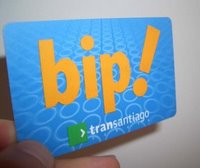Sam and I have been far too benevolent in sparing you from unrepetant econ geekery. That is until now.
Similar to New York and Washington DC, residents of Santiago use stored value cards to pay for public transportation — the onomatopoeically named “BIP” cards (based on the beeping sound the machines make after you pay).
(Sidenote: The subject of public transport in Santiago is actually quite fascinating. In 2007, the city undertook a top-level wholesale redesign of the entire system, which was formally largely decentralized. The results have been disastrous, resulting in a precipitous drop in the President Michelle Bachelet’s approval rating. Transantiago is her Iraq War from a public approval standpoint. Some thoughts from the Antiplanner here.).
Anyhoo … an observation that I am currently having difficulty explaining:
When people scan their BIP card, the remaining account balance is displayed on the scanner screen. I’ve noticed that the average card balances are usually less than 1000 Pesos (about $2.20 or 2.5 trips). This means that people who commute on public transport everyday are constantly charging their cards. I usually load mine up with 10,000 pesos each time ($22 or 25 trips). Why waste the time filling it up so often?
What determines the “rational” amount to put on your card?. It must be a balancing act of three factors:
1) The pain you would feel if you lost the balance on your BIP card (i.e. how much you value money)
2) The probability you assign to losing your BIP card
3) The annoyance you personally feel at having to load up your card frequently
But it seems that my preference for keeping a 10X balance to the average Chilean can not be fully explained by 1) (my relative wealth) and there is no reason to believe that 2) and 3) would be so different for me. Chile is not an impoverished country. This can not be explained by working capital constraints. GDP per capita is around $14,000 and is probably much higher along my bus route in my wealthy neighborhood of Santiago. What gives? Any ideas? Why do people wait in line to charge these cards almost every day?
Also, is there an interesting natural experiment on how people value money hidden in the BIP card data? Seems so, but I’m having trouble formulating it.
Tags: chile, economics, latin america

June 3, 2008 at 10:20 pm |
Am I missing the obvious? What about cash flow (ignoring those wealthy neighbors)? If your housemaid (por ejemplo) gets paid weekly, she probably can’t afford to buy a month’s pass up front.
An answer you might like better is that the low balance reflects a distrust of public transport, and services in general…Chilean’s don’t fear misplacing the card more than you but they worry that the system might alter the balance, devalue the cards, go on strike, etc.
June 3, 2008 at 10:31 pm |
What’s up Doc?
Don’t think it’s a cashflow issue because they are filling the cards multiple times between paychecks. I’m not talking about a month pass here. People only keep a day’s worth of charge on their cards! Why not 2 days? 3 days? This only makes sense if you are both *really* poor (working capital constrained) and get paid daily. This is definitely not the case for the average bus rider in my neighborhood.
The distrust is an interesting point … and something I’ve heard about in other contexts (e.g. using credit cards for E-Commerce). May write more about that later.
June 5, 2008 at 7:33 pm |
I’m guessing the reason is the other rider’s relative poverty. $14,000 doesn’t mean your starving, but it doesn’t put a lot of extra change in people’s pockets. Filling up your card is basically like carrying cash, and poorer people carry less cash for three reasons:
1. They spend it less quickly
2. They don’t want to be tempted to spend it frivolously (have you ever met that really cheap guy who hates to carry cash, or even break large bills?)
3. They care more about the additional float that they could be earning by storing the money elsewhere (as compared to the “anoyance” required to be constantly going to the ATM machine)
Okay, we won’t treat the third one, becuase that’s the stupid econ 101 answer that’s almost certainly irrelevant (5% of an extra $20 comes out to $1 for the year!).
You might argue that the first two don’t hold for the maid with a subway card because she takes the subway a lot and it’s not at all a frivolous expense. However how much they load on the card, is probably a function of cash habits and cash available (in the maid’s pocket). As a side question, do most people put money on the card with cash or credit/debit?
Anyway, poorer people (even if not POOR people) tend to spend less money and have much less of it in their pockets. Therefore:
1. Those habits carry over into the subway card habits
2. If they have less pocket money, they can load less at a time anyway
September 30, 2008 at 2:10 pm |
[…] responses: BIP! cards Some time ago, I posted an open question about why Chileans keep such low account balances on their subway cards (”BIP! cards”). Glen and Alisha came back with fantastic responses, each worthy of their own post. Alisha offers […]
May 2, 2013 at 9:03 pm |
Thank you, I’ve just been searching for information about this topic for quite a while and yours is definitely the best We have found out till now. But, what concerning the net profit? Do you think you’re certain in regards
to the supply?